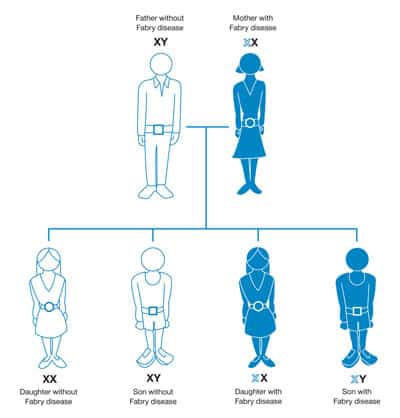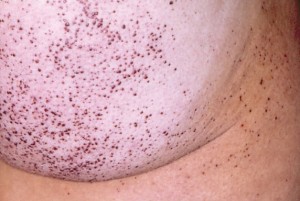Classification
The Fabry Disease is a hereditary disorder, caused by the lack of alphagalactosidase A. It is an x-linked recessive inheritance.  Therefore it is the females that carry it. The ones who are mostly affected by this disease are the males. Female carriers, though, may develop angiokeratomas and may have problems with burning pains. Very few of the carriers may also have kidney or heart problems. This disease occurs in 1 of 40,000 people.
Therefore it is the females that carry it. The ones who are mostly affected by this disease are the males. Female carriers, though, may develop angiokeratomas and may have problems with burning pains. Very few of the carriers may also have kidney or heart problems. This disease occurs in 1 of 40,000 people.
Description
A person with the Fabry disease develops angiokeratomas, which are clusters of raised, dot-like lesions. Appearing during childhood or puberty in the genital and thigh areas, these angiokeratomas increase in size and number. Other symptoms of this disease are burning pains in hand or feet, nausea, vomiting, abdominal pains, dizziness, headaches and generalized weakness. Swelling of the legs, caused by the gathering of lymph, a yellowish body fluid, under the skin may also occur. Skin will show telangiectasis, inflated intra-epidermal (intra – within, epidermal – outer layer) spaces filled with blood. Places (vessel wall) where there is no telangiectasis are filled with deposits of glycolipids. These deposits are also found in the heart, muscles, renal tubules and glomeruli, central nervous system, spleen, liver, bone marrow, lymph nodes and cornea. Retarded growth, delayed puberty and ocular abnormalities are also common symptoms. These symptoms are mostly fond in males because they display full-blown syndrome, while females displays a partial form.
Diagnosis
They firsts take a urine sample, which is the first place where they would find anything. Then they would take a blood, bone marrow and ophthalmologic examination. Prenatal diagnosis by way of Amniocentesis or Chronic Villus Sampling is also available.
Prognosis
People affected by this disorder usually die by the age of 40-50 from kidney failure or cerbovascular complications.
Treatment
There is only treatment to relieve the pains of the symptoms. Researchers are working towards the possibility of replacing the enzyme.
Bibliography
The Encyclopedia of Genetic Disorder and Birth Defects, By James Wynbrandt and Mark D. Ludman, M.D., F.R.C.P.C.
